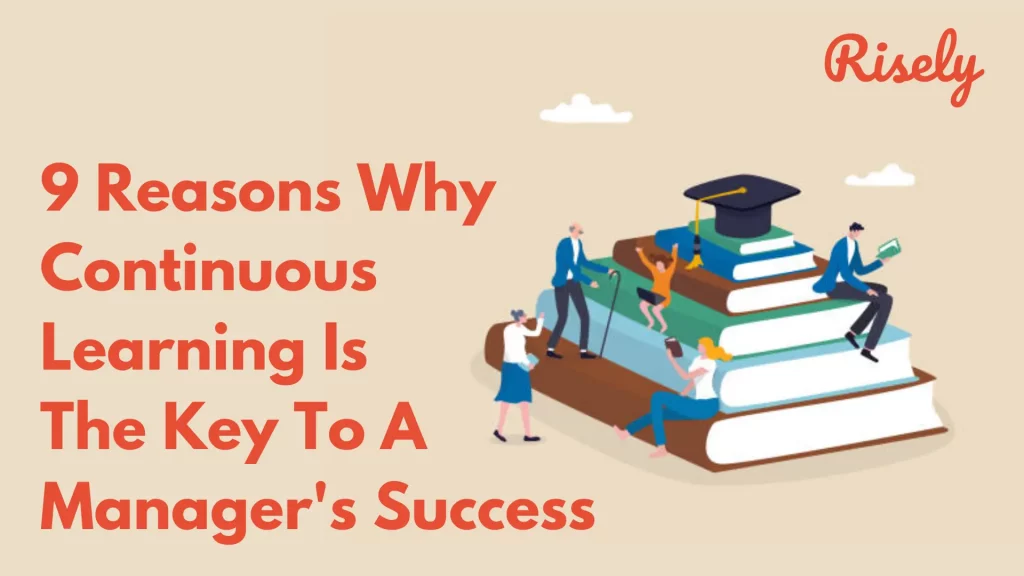9 Reasons to Focus on Continuous Learning
As a manager, you’re responsible for the success or failure of your team. To ensure that you’re up to the task, it’s essential that you continuously learn new things. This blog post will outline nine reasons why managers should strive for continuous learning and provide tips on how you can practice continuous learning in your life. By learning new things, you’ll be able to keep up with current changes in your industry, stay ahead of the curve, and make better decisions that will benefit your team. Other than that, we’ll also share tips on how a manager can encourage continuous learning in their team and how to measure the effectiveness of the same. So let’s start by understanding what exactly is continuous learning.- 9 Reasons to Focus on Continuous Learning
- What is continuous learning?
- Nine reasons why managers should strive for continuous learning
- How can managers practice continuous learning?
- How can managers encourage continuous learning in their team?
- How can managers measure the effectiveness of encouraging continuous learning in their team?
- Conclusion
- FAQs
- Other Related Blogs
What is continuous learning?
Continuous learning is the ongoing acquisition of new knowledge and skills, which helps you be more effective in your job and stay ahead of the curve. It is a commitment to consistently learn, grow, and improve in whatever one does. As a manager, you are responsible for ensuring that you and everyone in your team are constantly learning and growing. It means being proactive in seeking out new information, whether from reading articles, attending conferences and seminars, or any other possible medium. It also means being able to incorporate that new knowledge into your work. By doing this, you’ll be able to keep your team ahead of the curve and ensure that your team can meet the industry’s challenges. But is that enough to push a manager to strive for continuous learning? It is not that easy to make such a commitment to learn and grow continuously. So, why exactly should one get out of their comfort zone and find shortfalls in themselves and then go for learning to overcome them? Well, several reasons for it are enough to prove the necessity of continuous learning for managers. What are those reasons? Let’s find out in our next section.Nine reasons why managers should strive for continuous learning
A manager’s ability to learn is key to success in business. That’s why continuous learning is such an important priority. Here are nine reasons why managers should strive for continuous learning:Continuous learning leads to better decision making
Continuous learning significantly leads to better decision-making. By continuously learning new things, managers can understand different perspectives and weigh all the available information before making decisions. As managers gain more experience and knowledge, they can see things from different angles. It helps them arrive at wiser conclusions about what is happening in their workplace, which can help them make more informed decisions about how to react and manage the situation. Additionally, it allows them to develop practical problem-solving skills.Continuous learning strengthens relationships with customers, partners, and other stakeholders
When you’re constantly learning, you can effectively keep up with the ever-changing needs of your customers, partners, and other stakeholders. It strengthens your relationships with these stakeholders and allows them to trust and rely more on you. It also makes them more likely to recommend your services to others.Continuous learning attracts and retains the best employees
One of the significant reasons why a manager should strive for continuous learning is that it attracts and retains the best employees. But how? First, when managers are constantly learning new things, they are in a better position to understand their industry and the challenges their employees face. It gives them a competitive edge in negotiations and recruitment and fresh perspectives on managing their team. Secondly, continual learning by managers leads to a more vibrant workplace culture where employees are encouraged to challenge themselves and think outside the box. This motivates them to stay with the company more often and contribute their best efforts. In short, you must constantly learn new things as a manager if you want a thriving workforce.Continuous learning leads to creativity and innovation
Creativity is essential for any business and is critical in most industries. It is necessary for a competitive environment, where companies that can stay ahead of the curve tend to be more successful than those that don’t. Managers who are constantly learning new things can keep up with the latest trends and technologies, which means they can come up with better and more creative ideas and products. Innovation also plays a significant role in the creative industries. It’s one of the key factors that separate companies from their rivals, and it’s something that one can only achieve through continuous learning. By staying up-to-date on current trends and technologies, managers can develop new and more innovative ideas that set them apart from their competitors.It helps managers stay aware of new opportunities and challenges that may arise
There’s no such thing as a static world, and with the ever-changing business landscape, managers need to stay updated on new trends and developments. This is where continuous learning comes in. It helps managers remain aware of new opportunities and challenges and ensures that they can adapt their skillsets accordingly.It helps managers stay ahead of changes in the workforce and new technologies
In today’s business world, the workforce is constantly changing, and new technologies are continually being created. If managers don’t keep up with these changes, they’ll quickly fall behind and become obsolete. Continuous learning helps managers stay ahead of the curve and up-to-date with the latest changes in the workforce and new technologies.You’ll be able to keep up with or even stay ahead of the competition
It isn’t just a theoretical exercise; continuous learning has tangible benefits for managers. For example, it can help them stay competitive by ensuring that they have the latest information and technology at their disposal. It also allows them to develop new skills to help them perform better in their current or future positions. In short, striving for continuous learning is one of the best strategies for managers who want to stay ahead of the competition.Other Interesting Reads
Continuous learning makes you more knowledgeable
Managers who engage in continuous learning are more knowledgeable than those who do not. It is because constant learning allows managers to develop a broad range of skills and knowledge. It includes everything from technical know-how to professional expertise. Managers who regularly participate in activities such as reading, attending conferences, and taking courses are more likely to be up-to-date on trends and best practices.It will ultimately make you a better leader
All the beneficial outcomes of continuous learning and the ability to see the bigger picture prove that constant learning can benefit managers. It brings so many skills, knowledge, information, and opportunities for managers that it ultimately makes them better leaders. The reasons mentioned above must be enough for managers to consider practicing continuous learning. But how to go ahead with practicing it? Well, we do have some tips for you in the next section.How can managers practice continuous learning?
There are many ways that managers can apply continuous learning in their work. Here are five steps you can take to start practicing:1. Set learning goals and objectives
Setting learning goals and objectives is the first step for managers to practice a continuous learning process. These learning goals should be specific, measurable, and aligned with the business’s objectives. They should also be relevant to employees, customers, and clients interacting with the company. Goals should also be time-bound to be achieved within a specific timeframe.2. Make time daily to read, listen to audio recordings, or watch videos
Continuous learning can be done in several ways, but making time each day to read, listen to audio recordings or watch videos is an excellent way to begin.- Reading can give managers new insights and ideas and help them understand complex concepts more quickly. It can also increase your knowledge about different industries and how they work.
- Audio recordings, podcasts, and webinars can give you insights into different problem areas you may not have known about before and help you develop better solutions.
- Watching videos can give you an overview of different topics that you may be interested in, or it could provide you with practical tips that will help you improve your business.
- Follow experts in your area of focus on digital media and other sources. These days, experts keep sharing their wisdom in an easy-to-consume manner on social and other channels.

3. Seek out opportunities for hands-on experience
Managers who want to practice continuous learning should seek opportunities for hands-on experience. Hands-on experience allows managers to learn about different aspects of the job and how best to use their skills. You can do it by participating in new tasks around you, trying different ways of doing your tasks, shadowing your team members to identify and learn their unique skills, volunteering for opportunities that float within your organization, etc. By doing this, you can build on your skills and knowledge, which will help them improve their performance as managers.4. Take part in workshops, webinars, and seminars
One of the best ways to practice continuous learning is by participating in workshops, webinars, and seminars. These events offer various resources, including video presentations, discussion forums, case studies, and more. By engaging in these types of events, you’ll be able to learn from the best minds in the industry and keep up with the latest trends.5. Reflect on your learning experiences
Reflecting on your learning experiences is a significant and significantly important part of practicing continuous learning. One way to reflect on your learning experiences is to keep a learning journal. In your journal, you can write about what you have learned, how you have applied it, and what challenges you have faced. Keeping a learning journal is a great way to track your progress and ensure that you continuously learn and grow as a manager. It also allows you to look back on your experiences and reflect on what has worked well and what challenges you have faced. It is true that by following these tips and practicing continuous learning, managers will be well on their way to developing greater efficiency within themselves. But doing that won’t be enough to take the team to more significant potential. To achieve that, managers must also encourage continuous learning for their team members. How? We also have some tips for that in our next section.How can managers encourage continuous learning in their team?
Encouraging continuous learning in your team can be a challenge. Here are some tips to help you succeed:1. Communicate your learning goals and objectives to team members
To encourage continuous learning, managers must communicate their learning goals and objectives to team members. If everyone on the team knows what’s happening and what is expected, they’re more likely to be motivated to stay current and up-to-date. One effective way to do this is by setting up regular learning sessions. This way, everyone can join in and discuss the latest insights and developments as they happen. It also allows team members to ask questions and get help when needed. Managers should also prioritize ensuring that everyone on the team feels comfortable sharing their own experiences with learning. It will help them feel more connected to the learning process and motivated to continue growing as a professional. Check out more information on communication goals that a manager can set here!2. Encourage team members to participate in training and workshops
Encouraging team members to participate in learning opportunities like training and workshops regularly can be a significant step to ensuring continuous learning. Doing that will also bring many benefits to the team, including:- Firstly, training and workshops can help team members learn new skills essential for their work.
- Secondly, they can increase productivity by improving the team’s overall efficiency.
- Thirdly, team members who participate in training and workshops often develop better relationships, strengthening communication within the team.
- Fourthly, managers can be confident that their teams are up-to-date with the latest industry trends and developments.
- Fifthly, staff who are well-trained and proficient in their roles tend to be more customer-focused and customer-centric.
- Sixthly, well-trained and skilled staff often enjoy working in their field.
- Providing incentives (such as bonuses or salary enhancements) for team members who take part in training and workshops
- Praising team members for taking part in learning opportunities
- Setting a good example by participating in regular training and workshops yourself
- Wondering where to get started? Check out Risely today to unleash your team’s true potential!
3. Give team members opportunities to share their experiences and thoughts
Managers can encourage continuous learning by allowing team members to share their experiences and thoughts. It will help them grow, develop their skills, and learn from others in the team. By providing regular opportunities for team members to share their ideas, opinions, and insights, managers can help create a learning culture where everyone is encouraged to take risks and explore new possibilities. This environment will lead to a greater sense of teamwork and overall productivity.4. Celebrate individual successes and learn from collective mistakes
Another effective way to encourage continuous learning in the team is to celebrate personal achievements and learn from collective mistakes. When an individual achieves something, take the time to recognize their achievement. It will show your team that you are invested in their success and value their contributions. You can also use these moments to learn from your team member’s successes and apply them to the broader team. Similarly, when a mistake is made, it’s essential to take the time to learn from it. It will show your team that you are committed to continuous improvement and are willing to learn from your mistakes. You can also use these moments to learn from your team’s mistakes and apply the learnings to the broader team.5. Coach team members to help them foster a continuous learning environment
Managers can encourage continuous learning by coaching team members to help foster a continuous learning environment. It involves setting up an environment where team members are encouraged to learn and make mistakes to continue growing and improving as professionals. This type of environment is fostered by providing team members with the opportunity to exchange ideas and share their experiences and support when needed. All these tips will be enough to encourage continuous team learning effectively. However, how can a manager measure the effectiveness of their steps to promote continuous learning in their team? Let’s discuss that in the next section.How can managers measure the effectiveness of encouraging continuous learning in their team?
There is no one definitive way to measure the effectiveness of your continuous learning strategy. However, you can use a variety of metrics to gauge progress and success. Consider the following methods:Continuous measurement of skill gap matrix
To measure the effectiveness of encouraging continuous learning in your team, you must create a skill gap matrix. It will help you understand how much team members have improved their knowledge and skills. To generate the skill gap matrix, you’ll first need to gather data on all team members’ current skills and knowledge. Once you’ve created the skill gap matrix, it’s easy to track the progress of your team members by monitoring their scores regularly. You can do this by asking them to complete a questionnaire or conducting a survey. Next, you’ll need to compare this data with the data from when you began your training program. It will help you identify which areas of knowledge and skills have improved most.How often team members are engaged in training or workshops outside of work hours
Managers need to measure the effectiveness of encouraging continuous learning in their team to determine whether it’s worth continuing. They can do this by tracking how often team members are engaged in training or workshops outside work hours. You can get their attendance and engagement recorded and maintained by the trainers or workshop supervisors. It will display your encouragement’s influence on your team members’ willingness to learn.The number and variety of innovative ideas that are brought forward by the team
To get a clear picture of how well the team is doing, managers need to measure the number and variety of innovative ideas. They can do this in several ways, such as using surveys or interviews or reviewing performance data. Ultimately, managers need to keep track of how their team is performing to make informed decisions about how best to encourage continuous learning.Conclusion
As a manager, you must keep up with your field’s latest trends and knowledge. By striving for continuous learning, you can stay ahead of the curve and make better decisions for your team. Further, by encouraging and motivating your team to practice continuous learning, you can take your team towards more significant potential. So, if you are a manager, follow the tips mentioned above and practice ongoing education with your team to collectively achieve great heights.Get the free growth mindset toolkit to grow more with your team!
Practice continuous learning and inculcate a growth mindset in your team to achieve more everyday.
FAQs
Why is learning continuously important?
Learning continuously is important because it helps managers and leaders stay on top of a constantly moving industry. With rapid advancements in work methods and styles, managers need to be aware of the trends and latest developments so that their teams can make the best use of available opportunities. It also provides a constant source of motivation and progression in life. For team members, it can enable professional growth.
What is continuous learning in the workplace?
Continuous Learning in the workplace refers to the mindset of constantly learning from the experiences and other sources of knowledge at work. it can include modes like workshops and seminars, coaching, and self-help resources. It helps managers and teams develop robust responses to the changes coming to the industry.
What is an example of continuous learning?
An example of continuous learning is a person who works in the technology industry and consistently keeps themselves up to date with the latest trends and advancements in the field.
For instance, this person may attend regular workshops, conferences, or online courses to learn about new programming languages, software development methodologies, or emerging technologies. They may also read technical articles, research papers, or industry news to stay informed and gain knowledge about new and innovative technologies.
For instance, this person may attend regular workshops, conferences, or online courses to learn about new programming languages, software development methodologies, or emerging technologies. They may also read technical articles, research papers, or industry news to stay informed and gain knowledge about new and innovative technologies.
Other Related Blogs
How To Manage Work Life Balance? 7 Proven Hacks
How To Manage Work Life Balance? 7 Proven Hacks Finding a balance between work and personal life is a challenge many face today’s fast-paced and demanding world. The constant pressure…
10 Must-Have Soft Skills for Managers and How to Build Them in 2025?
When it comes to management, skills are everything. And that’s why soft skills are so crucial in the job. By understanding why these skills are essential, you can become an…
Looking for Personal Growth as a Manager? Here are the Top 10 Tactics
Looking for Personal Growth as a Manager? Here are the Top 10 Tactics Managers are responsible for the success of their teams, and their own personal growth is essential to…
What is Job Shadowing? Types and Benefits for Managers
What is Job Shadowing? Types and Benefits for Managers Are you a manager who wants to improve the skills of your workforce and create a more well-rounded and efficient team?…







